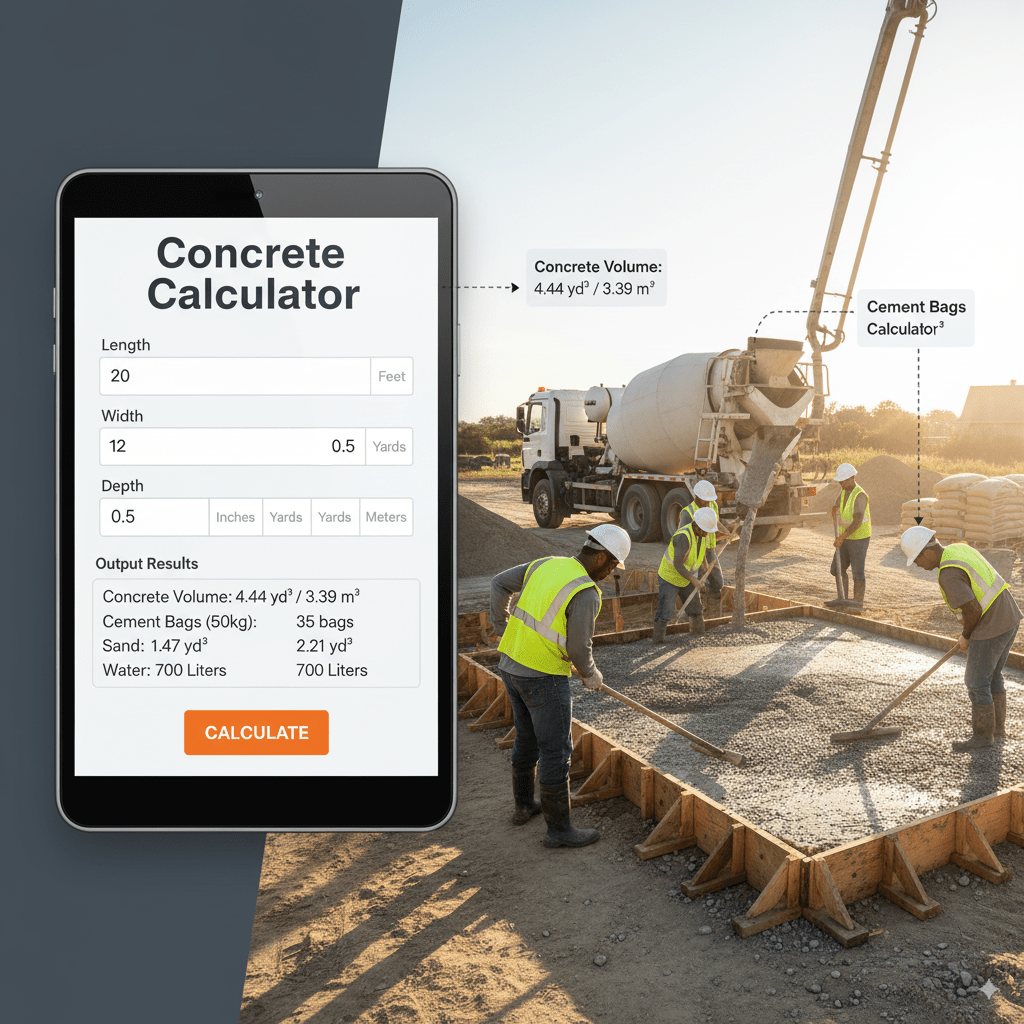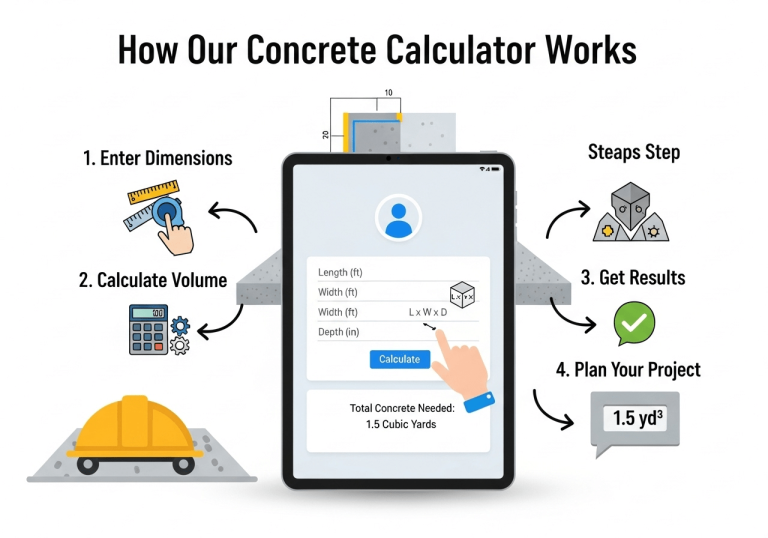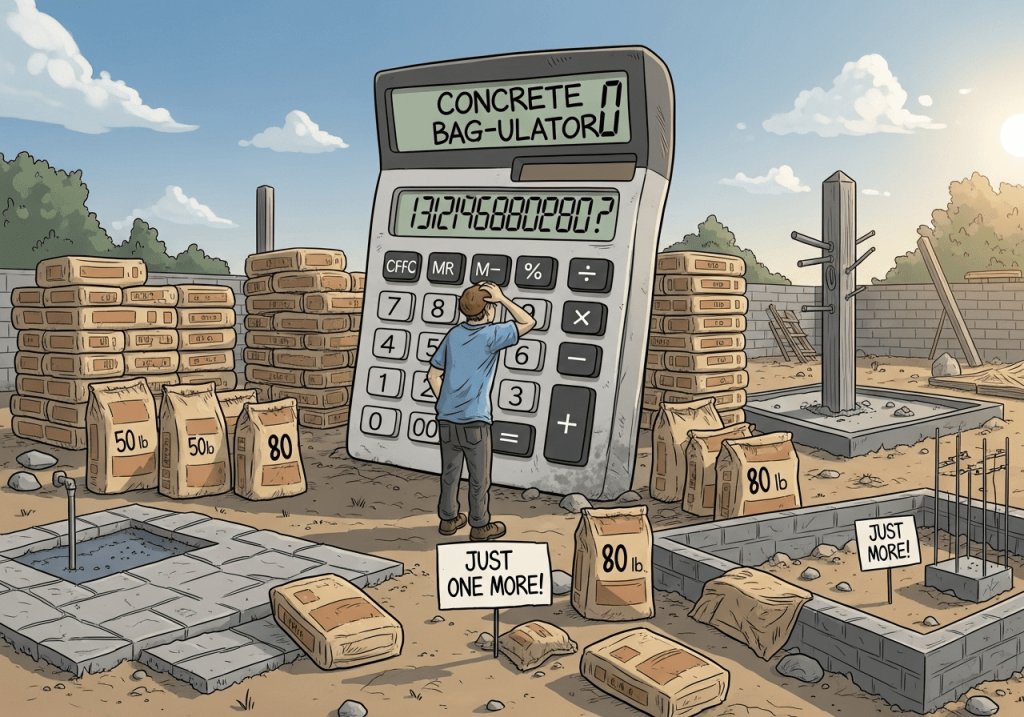Free Online Concrete Calculator | Quick & Accurate Results
Concrete Calculator – Quickly estimate the cement, sand, gravel, and water required for your construction project. Enter your dimensions, choose your unit, and get accurate results instantly.

Concrete Calculator
Table of Contents
Pouring Success: Your Ultimate Guide to Mastering Concrete with a Concrete Calculator
Every successful construction project, whether it’s a sprawling commercial complex or a humble backyard patio, rests on a solid foundation. And what’s the unsung hero of countless foundations, driveways, and structural elements? Concrete. But while concrete itself is robust and reliable, accurately estimating the amount you need can be a surprisingly complex and often daunting task. Underestimate, and you face costly delays and multiple trips to the supplier. Overestimate, and you’re stuck with wasted materials, disposal fees, and a dent in your budget. This is where the unsung hero of construction planning steps in: the concrete calculator.
Imagine a tool that takes the guesswork, the frantic scribbling, and the potential for expensive errors out of your concrete projects. That’s precisely what a concrete calculator does. It’s not just a handy gadget; it’s an indispensable partner for contractors, DIY enthusiasts, and anyone looking to tackle a concrete job with confidence and precision.
In this comprehensive guide, we’ll dive deep into the world of concrete calculation. We’ll explore what a concrete calculator is, delve into the myriad benefits of using a concrete calculator, and walk you through how to use a concrete calculator effectively. From understanding the basics of concrete volume to deciphering the number of bags you’ll need and even estimating the individual components like sand, gravel, and water, this article will equip you with all the knowledge to pour success into your next project.

Concrete Calculator Introduction: Demystifying Your Material Needs
At its core, a concrete calculator is a specialized digital tool designed to accurately determine the volume of concrete required for a specific area or structure. It takes the dimensions of your project – length, width, and depth – and, through a series of precise calculations, provides you with an exact volume. But it goes beyond just cubic yards or meters. A sophisticated concrete calculator can also break down that volume into practical quantities: the number of concrete bags you’ll need, and even the individual proportions of cement, sand, gravel, and water if you’re mixing your own.
Think of it as your personal quantity surveyor, available 24/7, without the hefty consultation fees. It transforms what could be a headache-inducing mathematical exercise into a few simple inputs and instant, reliable results.
Why You Need a Concrete Calculator: Beyond Just Guesswork
Whether you’re a seasoned contractor overseeing a multi-million dollar build or a homeowner embarking on a weekend DIY project, the question of “how much concrete do I need?” is paramount. The answer, often surprisingly nuanced, dictates your budget, timeline, and overall project efficiency. Here’s why a reliable concrete calculator isn’t just a convenience, but a necessity:
Financial Savings: This is perhaps the most compelling reason. Over-ordering concrete means paying for material you don’t use, potentially incurring return fees or disposal costs. Under-ordering leads to multiple delivery charges, project delays, and the hassle of trying to match a specific concrete mix. A precise calculation minimizes waste and maximizes your budget.
Time Efficiency: Time is money in construction. Waiting for additional concrete deliveries or scrambling to return excess material eats into valuable project hours. With an accurate calculation upfront, your material arrives exactly when and in the quantity you need it, keeping your project on schedule.
Accuracy and Precision: Manual calculations are prone to human error. A misplaced decimal, a conversion mistake, or a simple misread measurement can throw off your entire estimate. A digital concrete volume calculator eliminates these risks, providing consistent, accurate results every time.
Streamlined Project Planning: Knowing your exact material requirements allows for better logistics. You can schedule deliveries, allocate storage space, and plan your workforce more effectively. This holistic approach to planning is crucial for smooth project execution.
Reduced Stress and Hassle: Let’s face it, construction projects can be stressful. Removing the uncertainty around concrete quantities frees up mental energy, allowing you to focus on other critical aspects of the build.
Environmental Responsibility: Minimizing material waste isn’t just good for your wallet; it’s good for the planet. Less wasted concrete means less material going to landfills and a reduced carbon footprint.
Empowering DIYers: For the home improvement enthusiast, a concrete bag calculator transforms a potentially intimidating task into an approachable one. It provides the confidence to tackle projects like pouring a shed base, setting fence posts, or creating a stepping stone path, without the fear of miscalculation.
Professionalism for Contractors: For professionals, using a reliable concrete calculator underscores your expertise and attention to detail. It allows you to provide more accurate quotes to clients and execute projects with greater efficiency, enhancing your reputation.
From large-scale commercial construction to residential DIY endeavors, the concrete calculator is a fundamental tool that underpins successful, cost-effective, and efficient concrete work.
How Our Concrete Calculator Works: A Step-by-Step Guide
Our concrete calculator is designed for simplicity and accuracy, transforming complex volumetric equations into an intuitive user experience. Here’s a breakdown of how our calculator works, ensuring you get precise results every time:

Step 1: Inputting Your Project Dimensions
The core of any concrete calculation lies in understanding the dimensions of the area you intend to fill. Our calculator provides flexible input options to accommodate various project scales and measurement preferences:
Length: Enter the total length of your concrete slab, footing, or other structure.
Width: Input the width of your project.
Depth: This is crucial – sometimes referred to as thickness or height. This measurement determines the vertical volume of your concrete.
Crucially, you have complete control over the units for each input:
Feet: Ideal for larger outdoor projects like driveways or large slabs.
Inches: Perfect for more precise, smaller-scale work or when dealing with thickness measurements.
Yards: Commonly used in professional construction for large concrete orders.
Meters: For those working with metric specifications.
Centimeters: Another metric option for detailed or smaller-scale projects.
Simply select the appropriate unit for each dimension, enter your values, and the calculator will handle all the necessary conversions internally, ensuring a consistent final output.
Step 2: Processing the Data (Behind the Scenes)
Once you’ve entered your dimensions and selected your units, the calculator gets to work. It performs the fundamental volumetric calculation:
Volume = Length × Width × Depth
However, it doesn’t stop there. It then converts this initial volume into universally understood units and proceeds to estimate the quantities of constituent materials.
Step 3: Understanding Your Output Results
The true power of our concrete calculator lies in its comprehensive output results, providing you with more than just a single number:
Concrete Volume (m³ and yd³): You’ll instantly receive the total concrete volume required in both cubic meters (m³) and cubic yards (yd³). These are the standard units used when ordering concrete from a supplier or planning your mix.
Cement Bags (50kg each): This is a critical output for those planning to mix their own concrete or for estimating the number of pre-mixed bags needed. The calculator estimates the number of 50kg cement bags required, based on standard mix ratios. (It’s always wise to add a small percentage for contingency, typically 5-10%).
Sand: If you’re mixing concrete from scratch, the calculator will provide an estimated quantity of sand needed, usually in cubic meters or yards.
Gravel: Similarly, it estimates the required amount of gravel (or aggregate), also in cubic meters or yards.
Water (liters): Proper water content is vital for concrete strength and workability. The calculator provides an estimate of the water (in liters) required, crucial for achieving the correct consistency.
How These Results Help in Construction Planning:

These detailed results are not just numbers; they are actionable insights that significantly streamline your construction planning:
Accurate Ordering:
Concrete Volume (m³ and yd³): This is the direct quantity you’ll quote when calling a ready-mix concrete supplier. No more guessing, no more rounding up excessively.
Cement Bags: For smaller projects or DIYers, this tells you exactly how many bags of pre-mixed concrete to buy, or how many bags of cement to purchase if you’re mixing aggregates on-site.
Budget Control: With precise quantities for concrete, cement bags, sand, gravel, and water, you can generate an extremely accurate material cost estimate, helping you stick to your budget and avoid unforeseen expenses.
Logistics and Delivery: Knowing the volume in advance allows you to:
Schedule concrete deliveries well in advance.
Determine if a single concrete truck can handle the load (How Many Yards of Concrete Are in a Cement Truck typically varies by truck size, but a standard mixer can hold 9-11 cubic yards). If your project exceeds this, you’ll know to schedule multiple pours or trucks.
Plan for storage space for bags of concrete, sand, and gravel if you’re mixing on site.
Workforce Planning: Understanding the material volume helps estimate the time required for pouring, finishing, and curing, allowing for better labor scheduling.
Optimized Mix Ratios (for on-site mixing): The estimated sand, gravel, and water quantities ensure you maintain the correct concrete mix ratios for strength and durability, preventing issues like cracking or weak concrete.
By providing such detailed and practical outputs, our concrete calculator transforms an abstract concept of volume into tangible, actionable data, empowering you to plan and execute your concrete projects with unparalleled confidence and efficiency.
Example Calculations: Putting the Calculator to the Test

Let’s walk through some practical scenarios to illustrate how powerful and straightforward our concrete calculator is. These example calculations cover common project types you might encounter.
Example 1: Calculating for a Simple Concrete Slab (e.g., a Small Patio or Shed Base)
Imagine you want to pour a new concrete patio for your backyard shed.
Length: 10 feet
Width: 8 feet
Depth: 4 inches (which is crucial to convert to feet or use the inch unit option)
Let’s use our calculator:
Input Length: 10 (Feet)
Input Width: 8 (Feet)
Input Depth: 4 (Inches)
Our Calculator Results would show approximately:
Concrete Volume:
1.03 m³
1.35 yd³
Cement Bags (50kg each): Approximately 10-12 bags (this varies slightly based on standard mix ratios and if you factor in waste)
Sand: Approximately 0.45 yd³
Gravel: Approximately 0.67 yd³
Water: Approximately 200-250 Liters
How this helps: You now know you’ll need to order roughly 1.5 cubic yards (always round up slightly for safety) of ready-mix concrete, or if you’re mixing by hand, about 12 bags of concrete mix, along with specific amounts of sand, gravel, and water. This prevents you from making multiple trips to the hardware store!
Example 2: Calculating for Concrete Footings (Foundation for a Wall)
Suppose you’re building an extension and need to pour footings for a new wall.
Length: 25 feet
Width: 1.5 feet (18 inches)
Depth: 1 foot
Let’s use our calculator:
Input Length: 25 (Feet)
Input Width: 1.5 (Feet)
Input Depth: 1 (Foot)
Our Calculator Results would show approximately:
Concrete Volume:
1.05 m³
1.39 yd³
Cement Bags (50kg each): Approximately 10-13 bags
Sand: Approximately 0.46 yd³
Gravel: Approximately 0.69 yd³
Water: Approximately 210-260 Liters
How this helps: For footings, precision is paramount. Knowing you need almost 1.4 cubic yards allows you to confidently order from a ready-mix supplier or prepare enough materials for your crew to mix on-site, ensuring the foundation is poured correctly and continuously.
Example 3: Calculating for Concrete Flooring (Garage Floor)
Let’s say you’re replacing or pouring a new concrete floor for a standard single-car garage.
Length: 20 feet
Width: 12 feet
Depth: 6 inches
Let’s use our calculator:
Input Length: 20 (Feet)
Input Width: 12 (Feet)
Input Depth: 6 (Inches)
Our Calculator Results would show approximately:
Concrete Volume:
3.39 m³
4.44 yd³
Cement Bags (50kg each): Approximately 33-35 bags
Sand: Approximately 1.47 yd³
Gravel: Approximately 2.21 yd³
Water: Approximately 675-750 Liters
How this helps: A garage floor is a significant pour. Knowing you need around 4.5 cubic yards means you’ll likely need a small ready-mix truck, or multiple trips for material if you’re using pre-mixed bags and mixing by hand. The calculator clearly outlines the scale of the task, helping you prepare your equipment and manpower effectively.
These examples highlight the versatility and accuracy of our concrete calculator across different project types. By providing exact volumes and material breakdowns, it eliminates guesswork and fosters efficiency.
How Many Bags of Concrete Do I Need? Breaking Down the Bag Calculator

One of the most frequent questions for DIYers and smaller contractors is, “How many bags of concrete do I need?” While ordering a ready-mix truck is often more economical for larger volumes (typically above 2-3 cubic yards), bags of concrete are perfect for smaller projects like fence posts, small pads, or patching.
Our concrete bag calculator feature simplifies this by taking your calculated volume and translating it into the number of standard concrete bags. Most commonly, you’ll encounter bags in weights like 60 lb (27.2 kg) or 80 lb bag of concrete (36.3 kg).
Understanding the 80 lb Bag of Concrete
An 80 lb bag of concrete is a very popular choice due to its balance of workability and coverage. Typically, an 80 lb bag of concrete will yield approximately 0.6 cubic feet of mixed concrete.
To determine how many 80 lb bags you need, the calculator takes your total cubic footage (derived from your length, width, and depth inputs) and divides it by the yield per bag.
Example: How Many Bags of Concrete Do I Need for 1 Yard?
Let’s address a common query: “How many bags of concrete do I need for 1 yard?“
First, we need to know that 1 cubic yard is equal to 27 cubic feet (we’ll cover this in the FAQ).
If an 80 lb bag yields 0.6 cubic feet:
Number of 80 lb bags = Total Cubic Feet / Yield per 80 lb bag
Number of 80 lb bags = 27 cubic feet / 0.6 cubic feet/bag
Number of 80 lb bags = 45 bags
So, for 1 cubic yard of concrete, you would need approximately 45 of the 80 lb bag of concrete. Our calculator automates this entire process, giving you an immediate answer based on your specific project dimensions. Remember, it’s always good practice to add a few extra bags (5-10%) for spills, uneven subgrades, or last-minute adjustments.
How Many Yards of Concrete Are in a Cement Truck?
When your project demands a larger volume, a ready-mix cement truck is the way to go. But how much can one of these behemoths hold? “How many yards of concrete are in a cement truck” is a crucial question for logistics and scheduling.
The capacity of a standard ready-mix concrete truck mixer typically ranges from 9 to 11 cubic yards. Some smaller trucks might carry 6-8 yards, while larger ones can go up to 12-15 yards, though these are less common for standard residential deliveries.
Knowing your project’s total cubic yardage from our calculator allows you to:
Order Correctly: If you need 5 cubic yards, one truck is sufficient. If you need 10 cubic yards, you’re likely right at the limit of a single standard truck and might need to confirm the specific capacity with your supplier or plan for a second, smaller load or a second truck.
Plan Your Pour: Large pours might require multiple trucks, spaced out to allow your crew to work efficiently without material sitting too long. Our calculator helps you visualize the scale of your project in terms of truckloads.
This insight into truck capacity, combined with the precise volume from the calculator, ensures your concrete delivery is smooth and perfectly coordinated with your pour schedule.
How to Calculate Concrete Yards: The Foundation of Volume
While our calculator does the heavy lifting, understanding “how to calculate concrete yards” manually provides a deeper insight into the process and can be helpful for quick estimates. The principle is simple: determine the volume in cubic feet, and then convert to cubic yards.
Measure Dimensions: Get your length, width, and depth (thickness) in feet. If any measurement is in inches, divide by 12 to convert it to feet.
Example: A slab 10 feet long, 8 feet wide, and 4 inches deep.
Length = 10 ft
Width = 8 ft
Depth = 4 inches / 12 inches/foot = 0.333 feet
Calculate Volume in Cubic Feet: Multiply the three dimensions.
Volume (cu ft) = Length (ft) × Width (ft) × Depth (ft)
Volume (cu ft) = 10 ft × 8 ft × 0.333 ft = 26.64 cubic feet
Convert to Cubic Yards: There are 27 cubic feet in 1 cubic yard. So, divide your total cubic feet by 27.
Volume (cu yd) = Volume (cu ft) / 27
Volume (cu yd) = 26.64 cu ft / 27 cu ft/yd³ = 0.987 cubic yards
This manual process confirms the accuracy of the calculator’s output for the patio example we discussed earlier (where it showed approximately 1.03 m³ or 1.35 yd³ – the slight difference would be due to precise conversions and rounding). Our calculator streamlines these steps, eliminating the potential for mathematical errors and saving you valuable time.
Practical Tips for DIY Users and Contractors

Even with the best concrete calculator, a successful concrete project involves more than just numbers. Here are some invaluable tips for both DIY enthusiasts and seasoned contractors:
For DIY Users:
Measure Twice, Pour Once: This old adage is especially true for concrete. Double-check all your measurements before inputting them into the calculator. Even a small error in depth can lead to significant material discrepancies.
Account for Irregular Shapes: If your project isn’t a perfect rectangle, break it down into simpler geometric shapes (rectangles, triangles, circles), calculate each section, and then sum the volumes.
Always Order/Buy a Little Extra: Concrete projects rarely go exactly as planned. Subgrades can be uneven, spills can happen, and sometimes you just need a little more to achieve the perfect finish. A 5-10% contingency is a wise investment, especially if you’re using bagged concrete.
Prepare Your Site Thoroughly: Ensure your forms are sturdy and level, and your subgrade is properly compacted and moistened (to prevent it from sucking water out of your concrete mix).
Have the Right Tools Ready: Concrete sets quickly! Have all your trowels, floats, screeds, and safety gear ready before the concrete arrives or before you start mixing.
Get Help: Concrete work, especially pouring and finishing, is physically demanding and often requires multiple hands, even for small projects. Don’t go it alone if you can avoid it.
Understand Curing: Proper curing is critical for concrete strength. Keep your concrete moist for at least 7 days after pouring, especially in hot or windy conditions.
For Contractors:
Verify Site Conditions: Before relying solely on blueprints, conduct a thorough site survey. Unforeseen elevation changes, soil conditions, or existing structures can impact actual concrete needs.
Factor in Waste and Spillage: For large projects, always factor in a waste percentage (typically 3-5%) when ordering ready-mix concrete. This accounts for variations, spills, and slight over-excavation.
Communicate Clearly with Suppliers: Provide clear project details, access constraints, and desired delivery times to your ready-mix concrete supplier. Confirm the mix design (e.g., PSI strength, slump, aggregate size) to ensure it meets specifications.
Plan Your Pour Logistics: For large pours, consider pump trucks, proper access routes, and a well-coordinated crew. Stagger delivery times for multiple trucks to avoid bottlenecks.
Consider Additives and Admixtures: For specific project requirements (e.g., faster setting, increased workability, freeze-thaw resistance), discuss admixtures with your supplier.
Monitor Weather Conditions: Extreme heat, cold, wind, or rain can significantly impact concrete pouring and curing. Plan accordingly and have protective measures in place.
Quality Control: Implement rigorous quality control measures, including slump tests, air content tests, and cylinder breaks, especially for structural concrete.
Tool Calibration: Ensure any measuring tapes, levels, and screeds are calibrated and accurate.
By integrating these practical tips with the precision of a concrete calculator, both DIYers and contractors can approach their projects with greater confidence, efficiency, and ultimately, success.
FAQ Section: Your Concrete Questions Answered
We understand you might have more questions about concrete estimation. Here are some of the most frequently asked questions:
There are precisely 27 cubic feet in one cubic yard. This is a fundamental conversion to remember when working with concrete volumes.
The amount of concrete you need depends entirely on the dimensions of your project (length, width, and depth). To find out exactly how much concrete you need, use our concrete calculator by entering these three measurements, and it will give you the precise volume in cubic yards or meters.
The cost of a cubic yard of concrete varies significantly based on your location, the specific concrete mix design (e.g., strength, additives), the quantity ordered, and current market prices for cement, aggregates, and fuel. Generally, you can expect to pay anywhere from $100 to $170 per cubic yard for ready-mix concrete. Delivery fees can add to this, especially for smaller orders or remote locations. Always get a direct quote from your local concrete supplier.
As mentioned, there are 27 cubic feet in one cubic yard. This conversion is crucial for moving between common measurement systems used in construction.
A standard ready-mix concrete truck typically carries between 9 and 11 cubic yards of concrete. Smaller trucks might carry 6-8 yards, while larger ones can occasionally hold up to 12-15 yards. It’s always best to confirm the specific capacity with your concrete supplier when placing an order.
For a standard 80 lb bag of concrete which yields approximately 0.6 cubic feet, you would need roughly 45 bags to make 1 cubic yard of concrete. If using 60 lb bags (yielding ~0.45 cubic feet), you’d need about 60 bags per cubic yard. Our concrete bag calculator will do this conversion for your specific project volume.
An 80 lb bag of concrete typically covers approximately 0.6 cubic feet when mixed. To give you a practical idea:
For a slab 4 inches thick: one 80 lb bag would cover about 1.8 square feet (e.g., an area of 1.5 ft x 1.2 ft).
For a post hole 10 inches in diameter and 2 feet deep: you would need about 3-4 bags.
These are approximations, and actual coverage can vary slightly based on mix consistency and minor project variations.
Conclusion: Pouring with Confidence, Calculating with Precision
Concrete is the backbone of countless structures, providing strength, durability, and a lasting foundation. Yet, the initial step of accurately estimating its quantity can often feel like navigating a complex maze from the small DIY patio to extensive commercial footings; the cost and efficiency of your project hinge on getting this calculation right.
By embracing the power of a concrete calculator, you move beyond guesswork and into a realm of precision and confidence. You gain the ability to accurately determine not just the total concrete volume in cubic yards or meters, but also the number of concrete bags, and even the precise amounts of cement, sand, gravel, and water required for your specific mix. This level of detail translates directly into tangible benefits: significant cost savings by reducing waste, invaluable time savings by streamlining logistics, and the peace of mind that comes from knowing your project is built on solid calculations.
Whether you’re a homeowner looking to tackle a weekend project or a seasoned contractor planning a large-scale pour, our intuitive concrete calculator is your ultimate tool for success. It integrates seamlessly into your planning process, transforming what could be a headache into a streamlined, efficient, and cost-effective endeavor.
Don’t let concrete calculations be a stumbling block. Empower your next project with accuracy and efficiency.
Use our free Concrete Calculator now to save time and costs and pour your next project with absolute confidence!
Related Tools
Free Cement Calculator – Accurately estimate the amount of cement, sand, and water needed for your construction project.
Free Paint Calculator – Easily estimate the amount of paint required for your walls, ceilings, and rooms with accurate coverage results.
Free Brick Calculator – Find out the exact number of bricks and mortar required for your wall or construction project.

